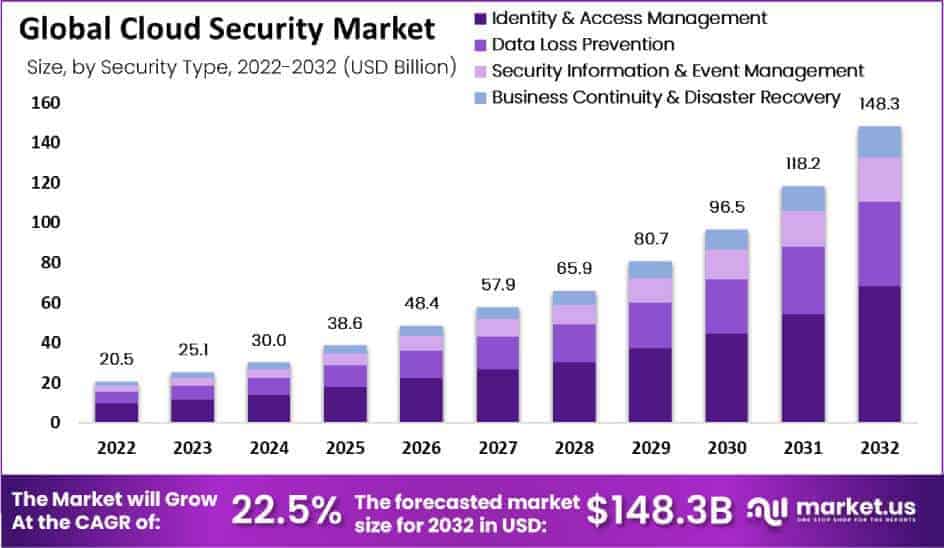In recent years, the cloud has emerged as a powerful and convenient solution for storing and accessing data – with over 61% of businesses using some form of cloud computing today.
However, with great convenience comes great responsibility, and it’s crucial to understand the potential security threats in cloud computing.
Our objective in this blog is to demystify the complex landscape of cloud security threats in a way your company can understand, and discover some effective ways to mitigate them. Stay protected by reading on!
Understanding the Threat Landscape of Cloud Security
Cloud computing has revolutionized the way organizations like yours are able to store, access, and manage data – but with this convenience also comes its own set of security threats that can potentially cripple your business if left unaddressed. This is no exaggeration, as over 60% of SMBs fail after just one instance of cyber attack .
This has caused the cloud security market to rise at a CAGR of 22.5% through 2032.

Among the different kinds of cloud computing security threats include:
- Data breaches
- Unauthorized access
- Malicious insiders
- Denial of service (DDoS)
- Malware
- Ransomware
- Employee error
- And more
To ensure robust cloud security, your organization must stay vigilant and employ a multi-layered approach, combining security precautions such as strong authentication measures, encryption protocols, regular security audits, and employee education to tackle these evolving threats effectively.
Let’s take a closer look at some of these common security threats in cloud computing today, and how you can stay safe with the help of a managed service provider (MSP).
Cloud Computing Security Threats : A Closer Look
1. Data Breaches: The Nightmare of Unauthorized Access
Data breaches remain one of the most significant cloud security threats today, with over 294 million people impacted every year . Hackers exploit vulnerabilities to gain unauthorized access to sensitive business data, such as customer information, financial records, and trade secrets. These breaches can result in severe financial losses, damage to reputation, and legal consequences – but the most common reason that they occur is a result of employee error.
Check out these additional resources to learn how an MSP can help you mitigate network and cloud computing security threats through cyber awareness training.
2. Account Hijacking: Taking Control of Your Cloud
Account hijacking occurs when cybercriminals gain unauthorized access to user accounts by exploiting weak passwords, phishing attacks, or social engineering techniques. Once inside, they can manipulate, steal, or delete critical business data within your c loud based system.
You must enforce strong authentication measures, such as multi-factor authentication, access controls , and shared responsibility model s, to mitigate this cloud computing security threat.
3. Distributed Denial of Service (DDoS) Attacks: Paralyzing Cloud Operations
DDoS attacks overwhelm cloud servers with a flood of malicious traffic, rendering them incapable of serving legitimate user requests. These attacks can disrupt business operations, cause downtime, and quickly result in financial losses.
In efforts to mitigate this cloud computing security threat , you should implement robust traffic filtering, load balancing, and DDoS mitigation solutions to safeguard their cloud infrastructure.
4. Malware Infections: The Stealthy Cloud Computing Security Threat
Malware infections are a constant menace to cloud computing. Malicious software can infiltrate cloud environments through infected files, email attachments, or vulnerable applications.
Once inside, malware can compromise data integrity, spread across networks, and even launch ransomware attacks. Regularly updating security software, performing system scans, and educating employees about phishing and malware prevention are crucial defense measures.
5. Data Loss and Service Disruptions: When Disaster Strikes
Cloud computing is not immune to disasters. Whether it’s natural disasters, power outages, or hardware failures, these events can result in data loss or service disruptions.
Your business must have comprehensive backup and disaster recovery plans in place to avoid these security issues , including regular backups and failover systems to avoid data loss and minimize downtime.
6. Misconfigured Security Settings: Leaving the Door Wide Open
Misconfigurations in cloud security settings can inadvertently expose critical data to unauthorized access. Improperly configured access controls, weak authentication methods, or incorrectly set permissions can create vulnerabilities that cybercriminals can exploit.
Regularly reviewing and adjusting security settings, following best practices, and leveraging security automation tools can help mitigate this risk – all of which your cloud service provider (CSP), aka your MSP, can help you with.
Mitigate the Risks of Cloud Security Threats with KDIT
There’s no surefire way to prevent hackers from gaining access to your cloud networks other than having a sufficient cloud security strategy in place.
At KDIT, we prioritize your data security, implementing robust measures to ensure the confidentiality, integrity, and availability of your valuable information. Expect to receive the following through our comprehensive cloud technology and security solutions :
- Continuous 24/7 IT support: Receive round-the-clock support and continuous monitoring services to keep your operations running smoothly.
- Data Protection: Avoid the devastating consequences of data loss by leveraging our built-in data backup and secure storage solutions.
- User-Friendly Experience: Effortlessly control and manage your data and cloud systems with our intuitive tools. We believe in providing a seamless user experience, enabling you to efficiently oversee your systems and optimize resource allocation.
Contact us today to learn more about how we can secure your cloud environments.
